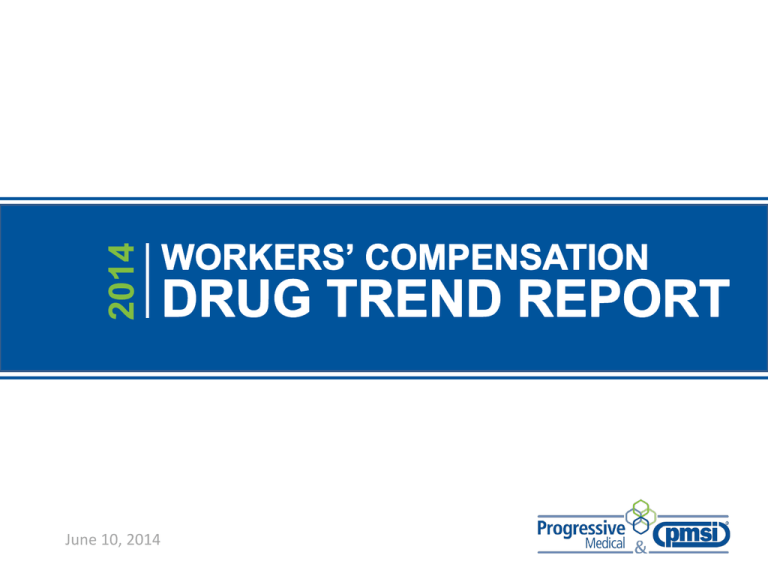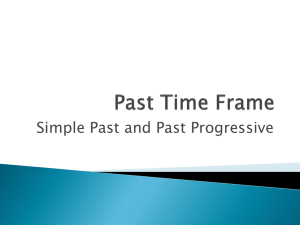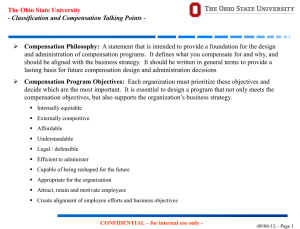
2014
APRIL 2013
June 10, 2014
Administrative Items
• Submit your questions via the webinar chat box
or Email marketing@progressive-medical.com
• Webinar recording will be available online at
www.firstfilltosettlement.com shortly after
the live session
• No continuing education credits are available
with this webinar
2014 Workers’ Compensation Drug Trend Report l Progressive Medical, Inc. and PMSI - Copyright 2014 - All Rights Reserved
2
Presenters
• Matthew Foster, PharmD
Clinical Pharmacy Manager
• Brian Allen, CIC
Vice President of Governmental Affairs
• Joe Anderson, MBA
Director of Analytical Services
• Tron Emptage, M.A., R.Ph.
Chief Clinical Officer
2014 Workers’ Compensation Drug Trend Report l Progressive Medical, Inc. and PMSI - Copyright 2014 - All Rights Reserved
3
Methodology
• 2012 – 2013
• Combines data from Progressive Medical and PMSI into a single data set
and was analyzed as one unit
• Over 300,000 claims and nearly six million prescriptions were analyzed
• Does not include transactions for clients with us fewer than two years
Overall Cost and Utilization Trends
• Strong network enforcement programs
7.8%
Average Wholesale Price
• Advanced analytics
6.3%
• Holistic utilization management
Average Cost per Days’
Supply
• Collaborative clinical interactions
3.2%
Product and Claim Mix
1.7%
Average Prescription Cost per
Claim
2014 Workers’ Compensation Drug Trend Report l Progressive Medical, Inc. and PMSI - Copyright 2014 - All Rights Reserved
5
Therapeutic Classes
• The top 10 classes represent 85% of the overall spend
• Overall spend of long-term opioid analgesics decreased 7.2%
• Generic utilization rate of 76%
2014 Workers’ Compensation Drug Trend Report l Progressive Medical, Inc. and PMSI - Copyright 2014 - All Rights Reserved
6
COST MANAGEMENT
Average Wholesale Price (AWP) Inflation
• The upward trend continues
• Both brand and generic medications affected
2014 Workers’ Compensation Drug Trend Report l Progressive Medical, Inc. and PMSI - Copyright 2014 - All Rights Reserved
8
Average Wholesale Price (AWP) Inflation
Brand
Generic
20%
Celebrex®
Cymbalta®
Lyrica®
More than 20%
Percocet®
Exalgo®
Fentora®
Amrix®
2014 Workers’ Compensation Drug Trend Report l Progressive Medical, Inc. and PMSI - Copyright 2014 - All Rights Reserved
6%
hydrocodone/APAP
7%
metaxalone
9
Mail Order
Effective mail order programs favorably impact cost containment
• For every 10% shift in days’ supply from retail to mail order, our clients
experienced a 1.2% reduction in spend
• Average days’ supply for mail order is 53.5 days compared to 24.6 days
for retail
• The average cost per days’ supply of mail order prescriptions was 17.3%
less than its retail equivalent
2014 Workers’ Compensation Drug Trend Report l Progressive Medical, Inc. and PMSI - Copyright 2014 - All Rights Reserved
10
Compounded Medications
0.62%
• We typically see topical formulations
• On average, compounded medications include 4-5 ingredients
• Represented 0.69% of total number of prescriptions, up slightly from 0.62%
2014 Workers’ Compensation Drug Trend Report l Progressive Medical, Inc. and PMSI - Copyright 2014 - All Rights Reserved
11
Specialty Medications
• Used to treat complex medical conditions including rheumatoid
arthritis, Hepatitis C, HIV and some cancers
• Encountered in workers’ compensation claims for occupations
such as emergency responders and health care professionals
• Specialty medications did not represent significance to our
book of business from the standpoint of either cost or utilization
2014 Workers’ Compensation Drug Trend Report l Progressive Medical, Inc. and PMSI - Copyright 2014 - All Rights Reserved
12
Network Enforcement
A key to successful cost containment is a PBM’s ability to drive transactions
“in network”
• Network discounts are applied to more prescriptions for greater cost savings
• Formulary controls, utilization edits and business rules are consistently
applied
• Collection, eligibility and verification calls are virtually eliminated; paper bills
virtually cease
• More data is captured allowing payers to proactively manage their claims
• Payers are better equipped to spot the warning signs of misuse and abuse,
which triggers an intervention earlier in the claim
• Therapeutic concerns are identified sooner allowing for more
informed and empowered medication management
2014 Workers’ Compensation Drug Trend Report l Progressive Medical, Inc. and PMSI - Copyright 2014 - All Rights Reserved
13
Through our efforts we achieve retail
network penetration rates up to
2014 Workers’ Compensation Drug Trend Report l Progressive Medical, Inc. and PMSI - Copyright 2014 - All Rights Reserved
98%
14
Network Enforcement
Our specialty network continues to expand to help optimize cost control
• Spend related to physician-dispensed medications decreased 14%
• Cost of physician dispensed medication was flat
• Top six states California, Florida, Illinois, Louisiana, Maryland and
Pennsylvania
2014 Workers’ Compensation Drug Trend Report l Progressive Medical, Inc. and PMSI - Copyright 2014 - All Rights Reserved
15
UTILIZATION MANAGEMENT
Claim Age
We realized a decrease in both utilization and prescription cost per claim in
all claims, even with a slight increase in claims aged ten years or older
0.62%
2014 Workers’ Compensation Drug Trend Report l Progressive Medical, Inc. and PMSI - Copyright 2014 - All Rights Reserved
17
Opioid Analgesics
• Our efforts, in collaboration with our clients
and industry stakeholders is starting to bend
the curve
• Metrics associated with utilization and cost
are all trending downward
0.62%
2014 Workers’ Compensation Drug Trend Report l Progressive Medical, Inc. and PMSI - Copyright 2014 - All Rights Reserved
18
Morphine Equivalent Dose (MED)
• Our programs are driven by evidence-based medicine, national and regional
approved guidelines and experienced clinicians
• Collaborative approach involving education, effective screening and careful
monitoring
• American College of Occupational and Environmental Medicine (ACOEM)
released an updated treatment guidelines limiting MED doses to 50 mg
per day
2014 Workers’ Compensation Drug Trend Report l Progressive Medical, Inc. and PMSI - Copyright 2014 - All Rights Reserved
19
Generic Utilization and Generic Efficiency
•
Generic utilization went up 1.9 points in 2013, moving from 74.1% to 76.0%
ANALYTICS, INTERVENTIONS,
AND CLINICAL INTERACTIONS
Analytics
Predictive analytics combines our expertise with industry and claim data to
identify which claims will result in long-term pharmacy costs
• Multi-variate, log-linear regression models predict pharmacy costs
• Data includes age, geography, prescriber, medications filled, and local
demographics to identify high-cost claims
0.62%
• Predictions allow for smarter
clinical triage and drive better decision-making
• Protects clients’ financial interests
• Optimizes therapy
2014 Workers’ Compensation Drug Trend Report l Progressive Medical, Inc. and PMSI - Copyright 2014 - All Rights Reserved
22
Interventions – A Couple Examples of our
Program in Practice
Our models accurately identify the claims that require attention
Early Intervention
Timing Begins after 120 days
Find the 10% of claims that make
Goal up 90% of long-term pharmacy
costs.
Our models identify 67% of the
Outcome claims that will be long-term
pharmacy cost claims
Long-term Intervention
Begins after 180 days
Target changes in behavior to any
chronic issues that have started to
develop
62% success rate in eliciting a
change to an injured worker’s
therapeutic regimen
2014 Workers’ Compensation Drug Trend Report l Progressive Medical, Inc. and PMSI - Copyright 2014 - All Rights Reserved
23
Clinical Interactions – A Couple Examples of our
Program in Practice
Our highly-trained team of clinicians is well versed in workers’ compensation
and medication therapy management
Multiple Prescriber Service
Urine Drug Testing and
Monitoring
Identify injured workers
0.62%receiving
Designed
medications from multiple
to
prescribers
Help payers and physicians confirm
the injured worker is adhering to
their medication therapy regimen
• 94% conversion to a single
prescriber
Results
• 9.6% decrease in total spend
for the study group
• 32% decrease in utilization of
opioid analgesics
• 26% reduction in total utilization of
all medications
2014 Workers’ Compensation Drug Trend Report l Progressive Medical, Inc. and PMSI - Copyright 2014 - All Rights Reserved
24
Claim Duration of Pharmacy Use
Shorter claim duration means fewer claims use prescription medications
years after the injury
Fewer active claims may influence:
• Loss ratios
• Combined operating ratios
0.62%
• Adjustor case loads
• Claim closure ratios
• Productivity
• Experience modifications
• Premium reductions
2014 Workers’ Compensation Drug Trend Report l Progressive Medical, Inc. and PMSI - Copyright 2014 - All Rights Reserved
25
INDUSTRY INFLUENCES
Aging Population
Typical Characteristics
• Body functions begin to decrease as early as the third decade of life
• Higher incidence of pain
• Prolonged recovery
• More prevalent psychiatric factors
What to Manage and Monitor
• Drug-to-drug interactions
• Intensified side effects
• Comorbid conditions
• Use of certain antidepressants as an adjunctive medication
2014 Workers’ Compensation Drug Trend Report l Progressive Medical, Inc. and PMSI - Copyright 2014 - All Rights Reserved
27
Comorbid Conditions
The presence of a comorbid condition may extend the duration of treatment
of the primary injury or become a compensable condition
2014 Workers’ Compensation Drug Trend Report l Progressive Medical, Inc. and PMSI - Copyright 2014 - All Rights Reserved
•
Depression
•
Insomnia
•
Obesity
28
Prescribing Practices
There are an increasing number of prescriptions for opioid analgesics being
written by nurse practitioners and physician assistants
2014 Workers’ Compensation Drug Trend Report l Progressive Medical, Inc. and PMSI - Copyright 2014 - All Rights Reserved
29
GOVERNMENT AFFAIRS
Closed Formularies
• Texas closed formulary became fully operational for all claims and
has achieved significant results by reducing “N” drugs by over 70%
and trimming reimbursement for these drugs by over 80%
• Oklahoma adopted a closed formulary that took effect February 1,
2014
• Louisiana and California are looking at adopting a closed formulary
2014 Workers’ Compensation Drug Trend Report l Progressive Medical, Inc. and PMSI - Copyright 2014 - All Rights Reserved
31
Compounded Medications
The FDA has called for stricter controls and many states are questioning the
efficacy and cost of compounded medications
• Oklahoma enacted guidelines requiring pre-authorization for all compounded
medications as part of their closed formulary
• Mississippi adopted a rule addressing how compounded medications can be
billed and when they should be pre-authorized
2014 Workers’ Compensation Drug Trend Report l Progressive Medical, Inc. and PMSI - Copyright 2014 - All Rights Reserved
32
Medication Rescheduling
The rescheduling of certain medications is a growing trend
• Hydrocodone products most commonly addressed
• Rescheduling impacts an injured worker’s ability to obtain a refill
• States with activity
– West Virginia passed legislation to move hydrocodone products
to Schedule II
– Louisiana just passed SB 618
– Consideration also at the Federal level
2014 Workers’ Compensation Drug Trend Report l Progressive Medical, Inc. and PMSI - Copyright 2014 - All Rights Reserved
33
Opioid Analgesics
Finding an effective way to curb the misuse and abuse of opioids continues
to be a key focus for stakeholders throughout the system
• The Ohio Bureau of Workers’ Compensation adopted standard dose weaning
schedules for opiates and a set of benzodiazepines
• Arizona passed legislation requiring pre-authorization, a medication agreement and
random drug testing for all Schedule II medications
• Florida and Alaska introduced legislation that requires drug testing
• West Virginia introduced legislation to ban non-abuse-deterrent hydrocodone products
• Virginia and New Jersey imposed stricter requirements to verify a
patient’s drug use history prior to prescribing or dispensing opioid
• Delaware enacted legislation to control the number and the cost of drug tests
2014 Workers’ Compensation Drug Trend Report l Progressive Medical, Inc. and PMSI - Copyright 2014 - All Rights Reserved
34
Pharmacy Choice
One of the best tools for controlling pharmacy costs is the use of a managed
care network
• New legislation could undermine the positive results that managed
pharmacy care has delivered to the various states’ workers’
compensation systems
• Alabama, Arizona, Iowa, Maryland, Mississippi, Missouri, New
York, and West Virginia have introduced legislation on this issue
2014 Workers’ Compensation Drug Trend Report l Progressive Medical, Inc. and PMSI - Copyright 2014 - All Rights Reserved
35
Physician Dispensing and Repackaged
Medications
• A challenge throughout the
country
• Inroads are being made
– Florida
– Delaware
– Indiana
– Hawaii
– Pennsylvania
– Utah
Prescription Drug Monitoring Programs
• States are re-tooling or
otherwise enhancing their
programs
– Enforcement
– Educational efforts
– Availability beyond state
borders
• Activities also occurring at
the Federal level
• We anticipate this will
continue
Medical Marijuana
• Legalization in growing
number of states is
generating conversation
• Schedule I classification at
the Federal level
• Does not have an assigned
NDC, so may not be
adjudicated
• Excluded from our
medication plans and
formularies
Looking Ahead
In 2014 and beyond we do not foresee any of today's challenges going away;
rather we will become even more adept at mitigating their influence
• Through product innovation and service enhancements we will work
with our clients to make our industry better, together
• We will use our balanced and unbiased perspective, veteran clinical
expertise, keen analytic insight, and strong moral compass to guide
us
2014 Workers’ Compensation Drug Trend Report l Progressive Medical, Inc. and PMSI - Copyright 2014 - All Rights Reserved
39
QUESTIONS?
Email to marketing@progressive-medical.com
2014 Workers’ Compensation Drug Trend Report l Progressive Medical, Inc. and PMSI - Copyright 2014 - All Rights Reserved
40
THANK YOU
View or request a copy of the complete report:
www.firstfilltosettlement.com






